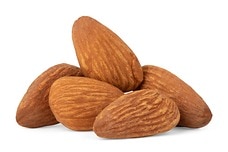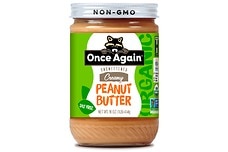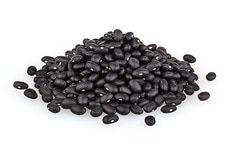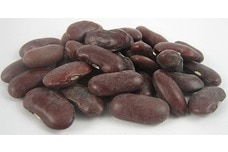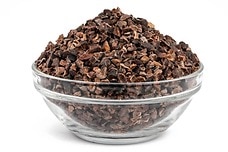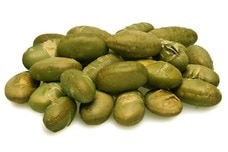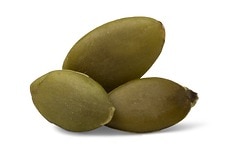Food & Snack Sources of Magnesium
Magnesium is found in many of the foods we eat and, although it's much more abundant in some foods relative to others, that's a good thing; because we need magnesium for many important bodily functions. A recent government study performed by the United States Department of Agriculture (2009) found American consumption of magnesium is well below the recommended dietary allowances (RDAs) for the mineral, which means that millions of men and women are at risk for diseases and complications associated with low magnesium levels.
What role does magnesium play in health, and what happens if I don't get enough?
Magnesium plays an essential role in more than 300 biochemical activities in the body, which include regulating blood pressure and heart activity, supporting the immune system, and maintaining nervous and muscular function (National Institutes of Health, 2016). Our metabolism – the process that changes the food we eat into nutrients our bodies can use – relies heavily on magnesium, and the mineral is also necessary for the synthesis of essential molecules like DNA, RNA and proteins (Linus Pauling Institute [LPI], 2014).
Magnesium is also essential for strong, healthy bones and cell signaling activities that help control the production and release of hormones. Plus, it's also actively involved in the wound-healing process and the process of cellular repair. Magnesium deficiency most often caused by not eating enough has been associated with an array of health issues, including increased risks for heart disease, high blood pressure, migraines, type 2 diabetes and osteoporosis (LPI, 2014).
How much magnesium do I need to stay healthy?
As with most nutrients, the amount of magnesium you'll need depends on your age and gender, as well as some other factors, like whether you're pregnant or nursing. According to the Institute of Medicine Food and Nutrition Board, the RDA of magnesium ranges from 310 mg to 320 mg for adult women and from 400 mg to 420 mg for adult men. Pregnant women need more – about 350 mg to 360 mg per day – to support the needs of a developing baby while also meeting their own nutritional needs (Institute of Medicine, 1997).
Teens from 14 years to 18 years of age (a period when rapid bone and muscle growth occurs) also need more magnesium – 360 mg per day for girls and 410 mg per day for boys. Teen girls who become pregnant need about 400 mg of magnesium each day (Institute of Medicine, 1997). If you eat a diet that's high in calcium, vitamin D or protein, you may also need to increase your intake of magnesium to maintain an optimal balance (U.S. National Library of Medicine, 2016).
What Are Some Good Sources of Magnesium?
As discussed, an adequate supply of magnesium is essential to your wellbeing. The good news is that magnesium is present in lots of foods, including “ready-to-eat” snacks like nuts and seeds, which makes getting enough of the mineral both easy and delicious. Magnesium is readily available in a variety of foods, the majority of which are plant based (WHFoods, 2014):
- Spinach: 157 mg magnesium per cup
- Pumpkin seeds: 191 mg per ¼ cup
- Soybeans: 148 mg per cup
- Black beans: 120 mg per cup
- Flaxseeds: 55 mg per 2 tablespoon serving
- Sesame seeds: 126 mg per ¼ cup
- Almonds: 62 mg per ¼ cup
- Cashews: 117 mg per ¼ cup
- Swiss chard: 151 mg per cup
- Summer squash: 43 mg per cup
- Navy beans: 96 mg per cup
As this list indicates, some of the most common food sources of magnesium include dark green leafy vegetables and nuts like almonds, cashews and peanuts. This includes both whole raw or roasted nuts and products made from the foods, including: almond, cashew, and pistachio flour; almond, peanut and cashew butters; and, yes, even chocolate-covered, honey-roasted, and butter-toffee-coated varieties of any and every nut (NIH, 2016).
Trail mixes including nuts, pumpkin or sunflower seeds, and raisins are also a great source of magnesium to provide a convenient, healthy, and tasty way to get your RDA for the nutrient. It should also be noted that magnesium is absorbed through the intestine – primarily the small intestine – and there is some evidence suggesting that consuming vitamin D along with magnesium may boost the rate at which the mineral is absorbed by the body (LPI, 2014).
Adding high magnesium foods to your diet can be as simple as including a midday snack of nuts or trail mix to your regular routine or spreading some almond butter on your toast in the morning. And you don't have to worry about getting “too much” magnesium from the foods you eat – any excess amounts will be eliminated through your urine (NIH, 2016). Make some room in your snack cabinet for a few of these healthy, magnesium-rich snacks, and start enjoying better health today.
Recipes Rich in Magnesium
The following recipes were formulated by our Health Nut and Registered Dietitian and have been selected due to their substantial magnesium content.
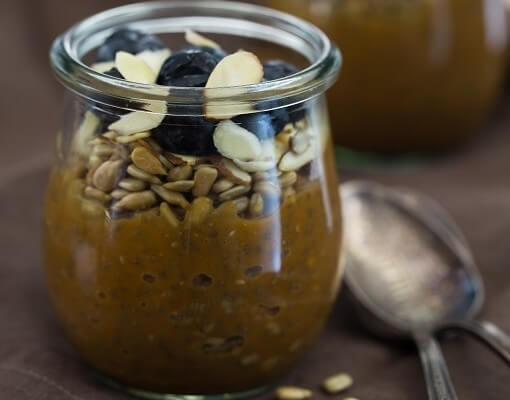
Pumpkin Chia Seed Pudding Recipe
A delectable breakfast selection, this palatable pudding combines the rich sources of pumpkin, chia, and sunflower seeds to produce a plate packed with that much-needed mineral, magnesium.
Ingredients: Milk, pumpkin puree, chia seeds, maple syrup, pumpkin spice, sunflower seeds, sliced almonds, fresh blueberries.
Total Time: 10 minutes
| Yield: 4 servings

Kale Quinoa Salad Recipe
This superb salad selects ingredients known for their saturated magnesium content to produce a powerhouse of the stuff in one delectable dish.
Ingredients: Quinoa, fresh baby kale, purple cabbage, carrots, fresh dill, boiled eggs, rice wine, extra virgin olive oil, black pepper.
Total Time: 25 minutes
| Yield: 8 servings
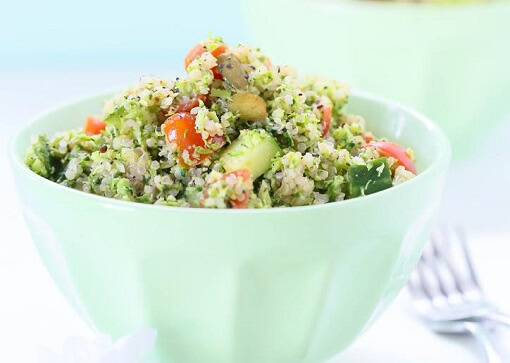
Broccoli Quinoa Salad Recipe {gluten-free}
A second salad with the superfood quinoa, this scrumptious salad offers an abundance of magnesium as well. Mix up your side salad and still maintain a healthy dose of minerals with this palatable plate!
Ingredients: Fresh broccoli, quinoa, cucumber, cherry tomatoes, raw pumpkin seeds, sea salt, black pepper, Dijon mustard (optional), vinegar, extra virgin olive oil, maple syrup.
Total Time: 1 hour
| Yield: 8 servings

Quinoa Stuffed Peppers Recipe {gluten-free}
A delectable selection for the main dish of your next dinner, these scrumptious stuffed peppers provide a myriad of nutrients, including our mineral of interest, magnesium.
Ingredients: Quinoa, green bell peppers, canned lentils, fresh spinach, feta cheese, frozen corn (thawed), salt, black pepper.
Total Time: 40 minutes
| Yield: 6 servings (8 half-peppers)
Snacks Sources of Magnesium
A recent study by Harvard found that increased circulating levels of magnesium may reduce the risk of heart disease (Chan. 2013). The Daily Value (DV) for magnesium is 400 milligrams for adults and children aged 4 and older, although keep in mind food labels aren’t required to list the amount of magnesium in a food, unless it is a product that has the magnesium added to it (NIH, 2016).
Check out this list of foods that will help you get your daily dose of magnesium!
Healthy Eating
- Healthy Highlights
- 5 Uses for Cacao Powder
- 5 Ways to Eat Farro
- 6 Best Gluten-Free Foods
- Alcohol and the Body
- Almond Flour Recipes
- Anti-Aging Superfoods
- Beat the Afternoon Slump
- Benefits of a Plant-Based Diet
- Benefits of Baobab
- Benefits of Cashews
- Benefits of Coconut Oil for Hair
- Benefits of Coconuts
- Benefits of Dates
- Benefits of Fenugreek
- Benefits of Garcinia Cambogia
- Benefits of Goji Berries
- Benefits of Kale Chips
- Benefits of Monk Fruit Sweetener
- Benefits of Peanuts
- Benefits of Pecans
- Benefits of Pistachios
- Benefits of Pumpkin Seeds
- Benefits of Spelt Flour
- Benefits of Steel Cut Oats
- Benefits of Sunflower Seeds
- Benefits of Tiger Nuts
- Benefits of Turmeric
- Benefits of Walnuts
- Benefits of Wheatgrass
- Best Food Fads
- Cacao vs Cocoa
- Caffeine-Free Energy Foods
- Chocolate That's Good for You
- Diet vs. Exercise
- Fat Burning Foods
- Food Myths Debunked
- Foods for Bone Density
- Foods for Colon Health
- Foods for Healthy Hair
- Foods for Healthy Skin
- Foods to Help Sleep
- Foods to Reduce Stress
- Green Tea Benefits
- Healthy Baking Flours
- Heart Healthy Habits
- High Protein Health Risks
- How to Boost Your Metabolism
- How to Lose Weight While Aging
- How to Throw a Vegan BBQ
- Kaniwa vs Quinoa
- Little Health Foods
- Low-Carb: Fad or Friend?
- Making Healthier Desserts
- Mediterranean Diet Meal Plan
- Natural Beauty Products
- Nuts for Weight Loss
- Preparing Vegan Meals
- Preventing Muscle Degeneration
- Rare Superfoods
- Reduce Sugar Intake
- Save Time By Going Vegan
- Smarter Snack Swaps
- Smoothie Ingredients
- Soy Protein vs Whey Protein
- Starting a Plant-Based Diet
- Steel Cut vs Rolled Oats
- Sugar Substitutes
- Vegan Proteins
- Vegan Substitutions for Fall Recipes
- Why Go Vegan
- Healthy Meals
- Healthy Recipes
- Sports Nutrition
- Nutrition and Special Diets
- 21 Day Fix
- 5 Popular Diet Similarities
- Alkaline Diet
- Anti-Inflammatory Diet
- Calorie Counting
- Carb Cycling Diet
- Celiac Disease
- Cholesterol
- Clean Eating
- Crohn's Disease
- DASH Diet
- Detox Diet
- Diabetes
- Diabetes Diet
- Diet Pill Dangers
- Fat Burning Foods
- Gluten-free Diet
- Glycemic Index
- Heart Health
- High Blood Pressure Diet
- High Fiber Foods
- How to Eat Healthy
- How to Lower Blood Pressure
- Hypertension
- IBS Diet
- Ketogenic Diet
- Liquid Diet
- Low GI Foods
- Low-Carb Diet and Foods
- Low-Fat High-Carb Diet
- Mediterranean Diet
- Mediterranean Diet Foods
- Military Diet
- Nutrition Labels Explained
- Paleo Diet
- Raw Food Diet
- Superfoods
- Sustainable Weight Loss
- Thrive Diet
- Vegan Diet
- Vegetarian Diet
- Weight Loss Shakes
- Whole30
- Vitamins, Minerals & Nutrients

